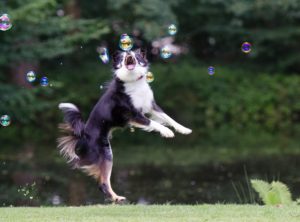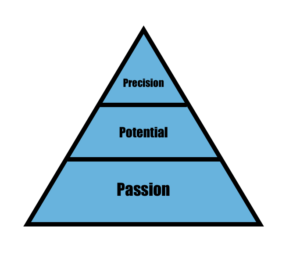by James Scott Bell
@jamesscottbell
 Some time ago I was asked on Twitter: “When you write first thing in A.M. do you work on current project or just write what comes to mind?”
Some time ago I was asked on Twitter: “When you write first thing in A.M. do you work on current project or just write what comes to mind?”
My reply: “Almost always my WIP. May do some free-form on occasion for warm up or chasing a new idea.”
The chase is what I want to talk about today. It involves five steps:
- Spark
- Nurture
- Development
- Analysis
- Green light
1. Spark
Where do ideas come from? Everywhere! A billboard, a dream, a news item, a bit of overheard conversation, a memory. Ray Bradbury would hop out of bed in the morning and write down whatever was in his head. Only later would he see if there was a whole story there.
Thus, for the creative artist, the question shouldn’t be Where can I get an idea? but Which idea should I nurture?
2. Nurture
Keep a list of the most promising sparks. Look at this list from time to time and see which ones cry out for more attention. Take these and nurture them into What if statements. I posted here about getting the spark of an idea watching the long-dead Peter Cushing make a CGI appearance in Rogue One. My spark was, Hey, maybe they’ll make movies someday with all dead actors. I nurtured that to: What if, in the future, a studio was making a Western with CGI John Wayne, and John Wayne (via AI) decided he didn’t like the script?
3. Development
Keep a file of your best What ifs. These are the ideas you’ll develop further. In the case of “John Wayne’s Revenge,” I developed it right into a short story. But most of my What ifs are ideas for full-length novels. I call this file “Front Burner Concepts.”
My preferred method of further development is what I call the “white-hot journal.” I got this from the great writing instructor Dwight V. Swain in his classic book, Techniques of the Selling Writer. Swain advocated writing a “focused, free-association document” for development. An hour to start with, at least. You’re not looking for structure, you are simply letting what Natalie Goldberg called the “wild mind” go wherever it wants to go: scene ideas, talking to yourself about why this idea is grabbing you, possible characters, settings, twists, turns, further ideas and possibilities, bits of dialogue.
Leave this document for a day, then go over it, annotate it, highlight the best parts, and add more free-form thoughts.
Do this again a third day. Start forming a cast of characters. I like to brainstorm a “relationship web,” possible connections the characters may have with each other before the story begins.
After a few days of this I have a mass of material that is starting to coalesce around a real plot. Now I’m going to ask some key questions:
- Are the stakes death (physical, professional or psychological)?
- Is there a motivated antagonist (person and/or group)?
- Are the characters starting to feel “warm” to me?
If I’m continuing to get excited, I’ll probably do some research. Since I set most of my books in Los Angeles, I’ll go “location scouting.” You always pick up great details doing live research. (See my post on this subject here.)
4. Analysis
How do you decide which project is going to take up the next three, four, six or twelve months of your writing life?
You start with Bell’s Pyramid.
Passion
The base of the pyramid is the most important. Without a passionate commitment to a story you’re burning to tell, your book will not be as original or vital or full of “voice” as it could be. You’ll risk sounding like all the cookie-cutter books competing in the marketplace. You might also get to the middle of the novel and be tempted to chuck the whole thing.
The key question here is, How emotionally invested are you in your main character? A novel, at its basic level, is about one character’s fighting a life and death battle using strength of will. That character will have to transform––becoming a fundamentally different (almost always better) person; or stronger (developing inner and outer resources in order to survive).
You should care about this character almost as much as a beloved family member. You should feel almost a need to see their story.
Potential
Now step back and consider the possible reach of your concept to an actual audience. Take off your artist’s hat and assume the role of an investor. If you were going to put up beaucoup bucks to publish your book, would it have a chance to recoup the investment and make some profit besides?
Find that sweet spot that joins your passion for the story with commercial viability.
Note, your assessment of potential need not be with the largest possible audience in mind. Genre writers know they are limiting themselves to a distinct group of potential readers. Even within genres, there are subgroups. Many science fiction writers, for example, are not writing “hard” science fiction, but rather books about deeply held philosophical ideas. They know that such novels appeal to some, and not to others. That’s fine. That’s a sweet spot, too.
Precision
Finally, be precise about your plot. You may be a plotter, you may be a pantser. In any case I advise you brainstorm the “mirror moment” for your Lead. It illuminates what your story is really all about and enables you to write organic scenes, no matter what your preferred plotting method. (Don’t worry, that moment is subject to change if the book demands it; but it’s best to have a lighthouse in a fog even if you end up in a different port.)
5. Green Light
As my wife likes to say out loud when the car in front of us has failed to notice it’s no longer a red light: “Green means go!”
And so you’re off. Write that first draft as fast as you comfortably can (refer to my post on working method here).
And that is how you chase, capture and animate an idea that you will turn into a full-length novel.
All you have to do now is add your genius.


Good advice. Probably better than my system, which tends to be “sit down and type and see what happens.”
Well, that worked for Bradbury, so you’re in good company! But a little more systemization probably is a good idea for us mere mortals. As the great philosopher Yogi Berra once put it, “You’ve got to be careful if you don’t know where you’re going, ’cause you might not get there.”
Yep. It seems I do better with prose on the page than notes. There’s a lot of regrouping, rethinking, and rewriting as I plod along, which is where your system would come into play. I think time spent comes out around the same.
This is such a succinct and organized outline of how you can go from the merest snippet of an idea into full-blown first draft. VERY helpful!
Thanks, Maggie. That’s what we at TKZ love to hear, that it helps a fellow writer. Onward!
Thanks, Jim. Great ideas.
I’d forgotten about the “white-hot journal.” I need to go back and read that section again.
And I love “Bell’s pyramid,” especially that the mirror moment belongs on the top (where it should rightfully be). If that pyramid, in its three-dimensional shape, has four sides to it’s base, there are four facets at the top, reflecting north/south/east/west with some great writing wisdom – a writer’s lighthouse. And if we switch facets and end up in a different port, we’ll still have a solid foundation for our story.
Any suggestions for what you would do differently if you were collaborating with another writer on a story?
I hope Kris, and others who write with writing partners, will comment on their process.
Thanks for another great post!
Holy Moly, Steve, you’ve cubed me. My head’s spinning. I’ll have to see if I can snag an idea or two …
I’ve had one collaboration (my Kit Shannon series) and it worked beautifully because a) my co-writer (Tracie Peterson) and I really got along on a personal level; and b) we hammered out our parameters before we started (i.e., who would do what, and when). I strongly suggest you get all that in writing, in order to save misunderstandings later.
I love it. My version of the “white hot journal” Is that I’ll create a bookmark file for it and zip any articles I find into that file. An unusual firearm. A cool piece of tactical gear. A healing plant, etc. I might have 2-3 going at any one time.
If it really sticks with me, I’ll create a document folder and dash off a few opening lines and maybe the plot points for an outline.
My resolution for this year is to finish all of those that have made it past 1000 words. Even if it turns into a short story or novella. I just pubbed SALT, which is a Kindle Worlds novella set in the post apoc sci-fi universe of Hugh Howey’s Sand. What inspired me is a spoiler, so no details, but I was driving up to Kansas City and saw it and it was “THAT’S IT!”
Next up? A YA prepper novella set in the universe of Steve Konkoly’s “The Perseid Collapse.” It’ll stress the prepper aspect more. I can still do it as a novel that emphasizes the relationships, but I’m also interested in doing a shorter more intense McGuyver-loaded version. Kindle Worlds is the perfect place for that. In general, it’s an experiment in selling shorter fiction. The inspiration? The twitter #MSWL (Manuscript Wish List) where an agent said, “I’d like to see something about teenage preppers.”
The other question that resulted in a short novel is “Why are all Civil War era historical romances set in the south?” And BOOM, “Burning Kansas” was born.
Working hard on the discipline to make it happen. Because I love this stuff.
Terri
You’re exploding with creativity, Terri. Nicely done. I’m excited for you and all that good stuff coming out of the keyboard!
The way you organize your creativity is so impressive, JSB. I felt like I was actually on top of things by jotting occasional ideas in their special red notebook. Apparently there’s lots more to do. Thanks for the inspiration, as always.
My pleasure, Laura. Happy jotting and developing!